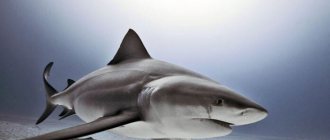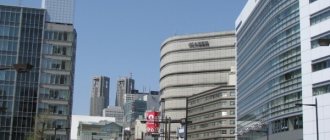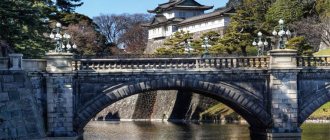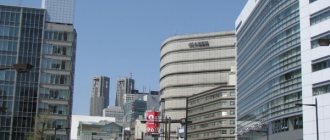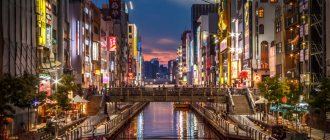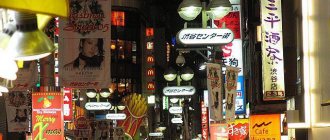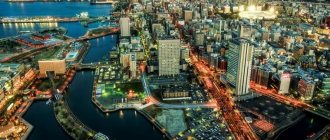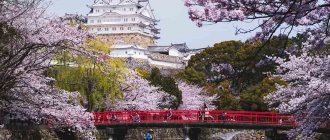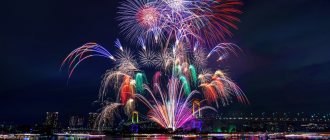The capital of Japan, Tokyo, is a metropolis that combines modern buildings with traditional temples. Guests of the Land of the Rising Sun are eager to see the richly decorated Meiji Temple with its high gates, the Emperor's Palace, and the Tokyo National Museum with unique works of art. Tourists visiting and traveling around Japan's capital need to understand the areas of Tokyo.
Let's take a look at the most interesting quarters of the city. At the same time, we will try to give advice to guests of the city in which area of Tokyo it is most comfortable to stay and in which neighborhoods the attractions of the capital of Japan are located.
Prestigious area
The most fashionable area in Tokyo is Ginza, which means “coin”. In 1612-1800 The Mint of the Land of the Rising Sun was located in the area, producing silver coins. The quarter is home to the best restaurants, fashion boutiques and first-class hotels, clubs and galleries. The streets of the Ginza quarter are much wider than in other areas, which is extremely atypical for traditional Japan, which values every centimeter of its area. The cost of a square meter of land in the Ginza quarter costs 100 thousand dollars, so the quarter is the most expensive area in Japan.
Attractions of the capital located in the Ginza district:
- The business center of the capital is Marunouchi.
- Ginza Wako Tower with shops selling unique luxury items.
- Emperor's Palace. Perhaps the main gathering place for tourists in this area. You can enter the palace only two days a year: December 23 and January 2. On all other days the palace is closed to tourists. It is worth noting that during such a period, a guest of the capital will be able to see a view of the Nijubashi Bridge, the Japanese Garden, and the ruins of ancient buildings.
- Kabuki Theater. Three- and five-hour performances in three or four acts are shown on the theater stage. You can watch them in full or purchase a ticket for one of the parts. At the performance you will be given headphones with simultaneous English translation.
Visa
Japan issues visa for free
, and recently an invitation from the guarantor, without which it was impossible not to enter the country, was removed from the list of requirements.
Now the list of documents is quite simple:
- Questionnaire in two copies;
- Two photos;
- International passport;
- Documents confirming the ability to pay for the trip (account statement or salary certificate);
- Stay program. This is a small table, each line in which is one day in Japan. In it you need to indicate the city you will be in, your contact phone number and address of residence, as well as your plans for the day (it is enough to indicate Sightseeing
, it is not necessary to list all the attractions that you plan to see); - Ticket booking confirmation.
All necessary documents and a sample form for filling out can be found on the official website of the Japanese Embassy in Kazakhstan. There is also an address in Nur-Sultan where you will need to bring a package of documents - this can be done in person or with the help of an authorized representative
.
If you have any questions, you can ask them using the embassy hotline: +7
(open
from Monday to Friday, from 4:00 to 21:00
).
Colorful area
Among Tokyo's districts, Asakusa is distinguished by the fact that it has retained the flavor of an old Japanese city. The area of the block is small, you can get around it on foot. Or take a rickshaw ride and explore the area on an inexpensive excursion for eight thousand yen for two. The quarter is famous among tourists visiting Japan due to the Buddhist temple of the same name located here. Its other name is Sensoji. This temple in the capital of Japan was founded back in 628.
Another Buddhist temple located near Sensoji is Dempoin Temple. It is notable for its garden. Unlike Sensoji Temple, this site is closed to tourist visits.
The Asakusa area hosts a large number of festivals. The most crowded:
- the ancient festival of Sanya Matsuri;
- samba dance festival.
Most of the historical and national monuments are located in Japan's first public park, Ueno, founded in 1873. It houses many museums:
- Museum of Western Art.
- Science Museum.
- National Museum of the City of Tokyo.
- Royal Ueno Museum.
- Tokyo City Art Gallery.
- Toshogu Temple.
Cultural district
This area of Tokyo is bustling with life every evening and every night. This explains why Roppongi is so popular among international visitors and native Japanese residents. A huge number of pubs, bars, cafes and restaurants, night discos and clubs are designed for the relaxation of foreign guests. Visitors not only relax here, but also live. It is worth noting that the best areas for foreign guests to live are: Roppongi, Hiroo, Azabu, Akasaka. It is in these neighborhoods, oddly enough, that the embassies of many countries are located.
Most tourists enjoy spending time in the Roppongi area. This Tokyo quarter is the cultural center of the Japanese capital, as it is home to a number of museums. The name Roppongi means "Six Trees" in the native Japanese language.
Capital attractions located in Roppongi:
- "Roppongi Hills" It is a city within a metropolis. It contains residential and commercial premises, entertainment areas, shops, restaurants, cinemas and an upscale hotel. The complex has about two hundred fashion boutiques. Roppongi Hills is a true symbol of the modern technology industry.
- Skyscraper of fifty-four floors Mori Tower. It is named after its creator. The center is divided into zones for the sale of all kinds of goods for life and recreation. There are commercial levels, apartments, hotels and museums in the blocks.
- Residential complex "Tokyo Midtown" with a tower of 248 meters. At the moment, the building is recognized as the tallest building in the Japanese metropolis. Almost all floors are given over to commercial facilities, with a hotel on the upper floors.
- Tokyo National Art Center, Suntory Art Museum and Mori Museum.
- National Art Center. It is considered the largest museum in the Land of the Rising Sun.
Transport situation
Tokyo has a very complex public transport system: there are only subway stations here 285
(and also buses, a monorail and one tram line).
What makes the situation even more confusing is that the metro is owned not by one company, but by two - the private Tokyo Metro
and the state-owned
Toei
. In addition, the city is divided into zones, where travel will cost differently.
“The Tokyo subway has 24-48-72 hour passes, but they don’t work on all lines. But with their help it is convenient to get to remote areas.
There are also general travel cards - Suica and Pasmo, on which you simply throw money, and then pay with it in transport or in stores and vending machines (for example, you can buy water). They don’t save money, but using them is much more convenient than standing at the diagram and trying to calculate what kind of ticket you need and how much it will cost. You can also pay for your bus fare with them.”
Tokyo Metro lines
costs from
170 to 310 yen.
If you plan to transfer to the
Toei
, you need to buy a special transfer ticket.
Pasmo cards
There are different denominations -
from 1000 to 10,000 yen
.
500 yen
of this amount is a deposit that will be returned to you if you return the card.
If you plan to move around the city very actively, you can take passes for a day or several days:
- 24-hour
pass for
Tokyo Metro
will cost
600 yen
, and for all
Toei
it will
700 yen
. - Pass for all subway lines ( Tokyo Metro
and
Toei
) -
900 yen for a day, 1200 for two days, 1500 for three
. - 24 hours
for all city transport (
Tokyo Metro
,
Toei
, including buses, as well as
JR
) -
1600 yen
.
Metro trains run every 5 minutes
,
from 5:00 to 23:30
(on some lines -
until midnight
).
Keep in mind that (most likely) you will only be traveling by subway - there are not many buses in Tokyo. However, the names of the routes on the buses are not duplicated in English, and most of them end at 21:00.
One bus ride costs between 200 and 300 yen
depending on the route and carrier company.
For those who plan to ride the bus all day, it is better to buy a daily Toei bus pass for 500 yen.
For those who are accustomed to cheap taxis, prices in Japan may be shocking (most likely unpleasant). Just for landing you will need to pay about 580 to 720 yen
, plus
80 yen for every 280 meters
and
90 for every two minutes of downtime
.
If you are traveling at night (from 23:00 to 6:00), then add another 30%
for the night rate.
If you plan to spend time not only in Tokyo, but also in other cities, then (very likely) you will get to them on the main Japanese transport - the high-speed train ( Shinkansen
). This is not a cheap pleasure, but it is a unique experience and the opportunity to ride trains from the future, which are unlikely to appear in Kazakhstan in the next 50 years.
The largest railway company in Japan is Japan Railways
(or just
JR
).
A Shinkansen ticket from Tokyo to Kyoto costs about 14,000 yen
one way.
a JR Pass especially for foreign tourists
- a one- or two-week pass that allows unlimited use of all
Japan Railways
.
“The most useful trains for moving around the country are Japan Railways. In Tokyo itself you can ride them around the central ring. They sell a pass for tourists, but it's expensive, so I'm not sure it's worth buying just for Tokyo. But with it you can get almost anywhere, and in any city JR has a central ring.”
JR Pass
for a week it costs
29,650 yen
. It's a lot, but it pays for itself in the first two to three days of your trip if you're traveling from city to city.
Since the pass is designed only for tourists, you need to buy it in advance - this cannot be done directly in Japan. You can pay for the pass on the website - after that you will receive a voucher by email, which you will need to exchange for a personalized travel pass at any JR
in Japan. You can activate it starting from any day, and then simply show it to the employee at the station when passing through the turnstiles.
To travel, you need to book trains in advance. To do this, select the desired shinkansen on the website, print the list and give it to a JR
, which will activate your pass. Along with activation, he will also book tickets for you. If your plans change, you can change your tickets without any problems.
Artificial area
The seaside district of Tokyo City Odaiba is another unique quarter of the capital of Japan. It partially expanded its territory on the artificial islands of the bay. When a tourist travels along the monorail, over the rainbow bridge, he can admire the Fuji TV building, which is 26 floors high. The building is decorated with a metal sphere; inside it there is an observation deck from which you can admire the expanses of the Japanese capital. In the Odaiba quarter there are world-famous museums:
- Museum of Marine Sciences;
- National Museum of Modern Science and Innovation.
Electronics District
The name of the Tokyo district Akihabara is translated from the native Japanese language as “valley of autumn leaves”. Akihabara is a place of modern trade in advanced technical products. Tourists visiting this area will be surrounded by billboards, street barkers, and loud music. Akihabara is a noisy place. There are hundreds of stores filled from top to bottom with different types of innovative technology. Compared to regular stores located in other areas of the metropolis, prices in Akihabara are approximately 30% lower. The reason for such attractive prices lies in the fact that the equipment comes to the shelves here directly from manufacturing plants without markups.
In the area you can visit an exhibition of industry achievements. After all, equipment from this area of Tokyo City will arrive in Moscow stores in a few months, or even years, at best.
Internet and other useful things
Please note that adapters are required to use Japanese sockets. We do not recommend buying them at the airport - it is better to find them at home in advance or get them at any hardware store in Akihabara (ask for an adaptor).
Almost everywhere in Japan there is free public Wi-Fi. But if you don’t want to search for a network and worry about being offline for at least five minutes, you can rent a portable Wi-Fi router - for example, on the same site that sells railway passes. Price for five days - 5450 yen
.
Wi-Fi will help you find your way - Google Maps
Here you can easily navigate not only walking routes, but also public transport.
If you are traveling from city to city and do not want to carry a suitcase with you, you can use the Kuroneko delivery service. They deliver suitcases from a hotel in one city to another in about a day and 2500 yen
.
Special position
Tokyo has 23 special districts that form the core and most populated area of the Japanese capital. In the entire Land of the Rising Sun, such a distinction exists only in Tokyo.
These areas differ greatly in area. It can range from 10 to 60 km2. The number of residents also varies in the quarters - from 40 to 830 thousand people. Some areas of Tokyo are expanding with artificial islands. We will talk about this below.
The population of special areas is just over eight million people. This is about 2/3 of the population of the capital of Japan and about 25% of the residents of Greater Tokyo. The quarters have a population density of almost 14 thousand inhabitants per square kilometer.
Special areas of Tokyo:
- Arakawa.
- Adachi.
- Bunke.
- Itabashi.
- Katsushika.
- Kita.
- Koto.
- Minato.
- Meguro.
- Nakano.
- Nerima.
- Ota.
- Shibuya.
- Shinagawa.
- Shinjuku.
- Suginami.
- Sumida.
- Setagaya.
- Taito.
- Tieda.
- Toshima.
- Chuo.
- Edogawa.
Let us describe some of them in more detail.
Multi-ethnic area
The most multinational district of Tokyo is considered to be the Shinjuku quarter, which is the main transport hub of the Japanese capital. Currently, the capacity of the three-tier platform at the western entrance of Shinjuku alone is equal to a billion passengers. All the active life of this cosmopolitan area basically takes place around the quarter station. This accumulation of passengers determined the structure of the quarter. People need food, shopping - gradually, the narrow streets heading in all directions from the station began to be filled with cafes and eateries that are popular in the Land of the Rising Sun.
Shinjuku is divided into two parts by train tracks:
- Eastern. Active modern life is in full swing in the eastern part of Shinjuku, where the longest red light district in the country is located.
- Western. In the business part of the quarter, in the west, the headquarters of the Tokyo city administration is based - Tote.
Between the eastern and western parts there is a beautiful park - Shinjuku Goen. In the spring, it attracts tourists to the country with a spectacle of incredible beauty - the blossoming of Japanese cherry trees.
Capital attractions located in Shinjuku:
- Sompo Japan Building. The skyscraper is 193 meters high.
- Shinjuku Historical Museum.
- National Theatre.
- Taisoji Buddhist Temple.
There are many foreigners living in the Shinjuku area of Tokyo. This is the shopping and entertainment center of the capital. Towards evening, the area begins to experience noisy nightlife. Shinjuku has a large number of restaurants, cinemas, and gaming halls.
The cult of food is so strongly developed in Tokyo that it has spread even beyond Japan and served as an impetus for the development of the restaurant business, in particular in our country. In the Northern capital, Tokyo City restaurants are open in almost all districts of the city. In the Primorsky district, a restaurant is open on Komendantsky Avenue. The restaurant menu offers Japanese cuisine, as well as Italian and Chinese. You can order food delivered to your home from Tokyo City to the following areas: Moscow, Primorsky and any other.
How to get there
Air tickets are one of the most expensive elements of a trip to Japan (along with housing). But if you buy them in advance, you can save money.
There is a direct flight from Nur-Sultan with SCAT Airlines
- approximately
8 hours
and you are at Narita International Airport.
Return tickets cost from 221,000 tenge
.
Air China also has regular flights from the capital
and
China Southern
- they make one connection in Beijing or Guangzhou (if
there are less than 72 hours
, then you do not need to obtain a Chinese visa, but it’s better to check with the airline).
If you are afraid to fly to China, you can take Aeroflot
with a transfer in Moscow Sheremetyevo - or
S7
with a transfer in Novosibirsk.
Round-trip tickets with a transfer cost about 200,000 tenge
.
Flying from Almaty is more expensive, and there are no direct flights - you will have to make at least one transfer. The most affordable flights from S7
(transfer in Novosibirsk, a total of
13 hours on the way
) - approximately
225,000 tenge
.
From Kazakhstan to Tokyo you can find many complex flights - with three or even four transfers. Sometimes they are cheaper, but not significantly. In addition, being on the road for 20–40 hours
difficult (not only physically, but also mentally), so it’s better to pay a little extra, but get there faster.
Tokyo's main airport is Narita
, it is located in the suburbs.
There are several ways to get from here to the city center:
- By high-speed train N'EX, which about an hour
to Tokyo
Station
.
For a one-way ticket you need to pay 3070 yen
. - The Skyliner train takes
about
40 minutes
Ueno .
Ticket costs 2520 yen
. - There are also buses that take from an hour to two hours
.
Tickets for the LimousineBus start at 2,800 yen
one way, and the KeiseiBus shuttle costs
1,000 yen
. - Taxis in Japan are very expensive, so you should be prepared to pay about 20,000-25,000 yen
. As an option, an individual transfer for about the same money, which can be ordered in advance from KiwiTaxi or Intui.Travel.
Youth District
Shibuya is an area of Tokyo where young residents of the Japanese capital prefer to spend their free time. This area has a vibrant nightlife scene with loud music coming from every pub and bar. Shibuya is also a great place for shopping. Tourists will be offered entertainment in this quarter. Hotels located in the Shibuya area offer rooms for the whole night for a maximum of one hundred dollars.
One of the most famous points in Shibuya is Hachiko Station. The name was given to it on behalf of the bronze statue installed here. The monument to the dog Hachiko personifies devotion to his owner. Everything around the station is lit up with billboards; commercials are broadcast on a huge screen.
Capital attractions located in Shibuya:
- Museum of Tobacco and Salt and Museum of Electric Power. A significant disadvantage for tourists is that excursions in these museums are in the native language of the Japanese.
- Yoyogi National Stadium with outdoor ice skating rink.
- Park studio of the NHK television company.
